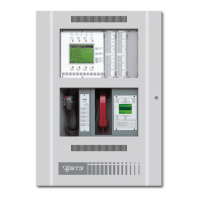Access control applications
3.8 EST3 Installation and Service Manual
Other factors
Next, we’ll cover the additional factors listed on the drawing:
• Power supply
• Hardware configuration
• SDU programming
• ACDB/KDC operation
These factors are called out on each application diagram given in
this chapter.
Power supply
The CRC is designed to operate on 24 Vdc. For this reason, we
recommend that you include power from the panel with the SAC
bus cable. You can use the panel 3-PPS/M or 3-BPS/M power
supplies.
When using CRCXF CRC Transformer you must provide a
circuit common path between all devices, using the –24 Vdc
terminals.
If you use an additional power supply other than the CRCXF,
that power supply must be listed for fire alarm applications, must
have ground fault detection disabled, and must have a circuit
ground (circuit common) that is isolated from earth ground.
Hardware configuration
The CRC has two jumpers that configure the power source and
usage for the module. See the CRC installation sheet for details
on the jumper settings.
No other configuration settings are made at the device itself. All
other configuration is done via SDU or ACDB programming.
The SDU determines site-level configuration and parameters.
The ACDB program controls end-user settings.
SDU programming
While the ACDB program defines the access control database,
all other definition, configuration, and programming for the
access control system happens in the SDU.
The SDU controls the general configuration of the 3-SAC
modules, plus the configuration of all CRC devices on the SAC
busses.
CRC modules can be configured to execute a specific,
predefined command list when a specific access control event
occurs. You write the command lists in the SDU, and assign
them to CRC events when you configure the CRC module.

